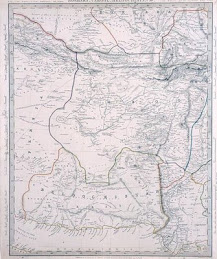 Pressures to stop drone attacks on suspected terrorist hideouts in the tribal border regions of Pakistan focus properly on human-rights concerns. More and more evidence shows that the attacks are hitting innocent villagers with no ties to terrorist groups.
Pressures to stop drone attacks on suspected terrorist hideouts in the tribal border regions of Pakistan focus properly on human-rights concerns. More and more evidence shows that the attacks are hitting innocent villagers with no ties to terrorist groups.But apart from humanitarian issues, the drone attacks are self-defeating politically because they are radicalizing the tribal Pashtuns. Hitherto quiescent politically, more and more of the border tribes are turning to local Pashtun leaders who advocate aggressive resistance to attempts by the Punjabi-dominated central government in Islamabad to assert control over the Pashtun areas.
So far, this spirit of resistance has not led to active support of the long-standing demand of Pashtun nationalists for a sovereign “Pashtunistan” uniting Pashtun areas on both sides of the Afghanistan-Pakistan border. But continued civilian casualties in Afghanistan, like the 35 on February 21 near Jalalabad, rekindle the simmering Pashtunistan sentiment on the Pakistani side of the border.
The conventional wisdom is that the US interest lies in a united multi-ethnic Pakistan. But Mark Katz argued persuasively in The National Interest Online that the United States should adopt Machiavellian tactics, using the threat of support for Pashtunistan as leverage to get Pakistan to stop aiding the Taliban in Afghanistan. Such tactics would require a termination of drone attacks and a cessation of the current US pressure on the Punjabi-dominated Pakistan Army to carry out ground and air offensives against Waziristan tribes.
The British Raj gave the tribal borderlands of Pakistan undisturbed autonomy. Pakistan initially recognized the wisdom of this approach, letting the tribes alone until the United States demanded active intervention to stop the use of the borderlands as a Taliban supply route after American forces intervened in Afghanistan.
Critics of the drone program point out that only two of 581 militants believed to have been killed last year are on the “most wanted” list of US terrorists. As The Washington Post reported: a program that began with intermittent lethal attacks targeted on Al Qaeda leaders has evolved into a campaign that now seems primarily focused on lower-level leaders. Peter Bergen of the New America Foundation told the Post that 94 percent of those killed are lower-level militants.
The number of drone strikes in 2010 rose to 118, each costing $1 million. This $118 million should have been spent instead on economic aid for the tribal areas. But no economic aid program would be welcome if it is dispensed by the Punjabi-dominated Pakistan central government. The Pashtun tribes of the borderlands do not want to become an extension of the Punjabi-dominated central government machinery. They want aid to be channeled to them directly for their autonomous use or through the Pashtun government of the Northwest Frontier Province.
To win the support of the border tribes, the United States would either have to adopt the tactics proposed by Mark Katz or at least make clear to them that it favors their economic independence from Punjabi domination within the Pakistani federation.
There would be a case for them if the drone attacks did indeed offer a way to stamp out terrorist hideouts in Pakistan threatening to the United States. But the fact that only two of the most wanted US terrorists were killed by the program should in itself be enough to kill it. As Bruce Riedel, the former head of South Asia activities at the CIA, told me: “the present approach is like going after a beehive bee by bee.”
hhttp://nationalinterest.org/commentary/america-builds-pashtunistan-4928
Selig S. Harrison
Selig S. Harrison is director of the Asia Program at the Center for International Policy.
Commentary
America Builds Pashtunistan
| 02.28.11
"Principled" Hawks Risk North Korea
| 02.23.11
A Chinese Civil War
| 02.07.11
Free Baluchistan
| 02.01.11










































No comments:
Post a Comment